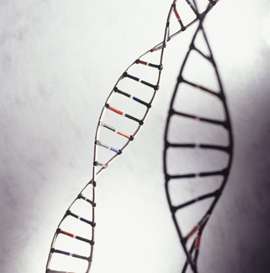Molecular clocks control mutation rate in human cells

Every cell in the human body contains a copy of the human genome. Through the course of a lifetime all cells are thought to acquire mutations in their genomes. Some of the mutational processes generating these mutations do so in bursts and these will often be through external exposures such as sunbathing or tobacco smoking. Other mutational processes, however, may be internal to the cell and generate mutations continuously, at a constant rate over decades. If so the mutations they generate will be "clock-like", with the number of mutations present correlating with the age of the person. In research reported in Nature Genetics two clock-like mutational processes have been found in human cells and the rates at which the two clocks tick in different human cell types have been determined.
These clock-like mutational processes could ultimately be responsible for a large proportion of human cancer and contribute to human ageing.
The genomes of cancer cells held the key to finding these molecular clocks. Previous work on cancer had revealed that mutations often leave a molecular fingerprint, called a mutational signature, on the genome of a cancer cell. To identify the mutational signatures of clock-like mutational processes in the human body, this study looked at the DNA sequences of 10,250 cancer genomes, from 36 different types of cancer.
The researchers found 33 mutational signatures in the cancer genomes, but only two had clock-like features. These two clock-like processes, termed Signature 1 and Signature 5, showed a correlation between the number of mutations found in each cancer sample and the age of the patient when the cancer was diagnosed.
"This is a hugely exciting finding as it solves a longstanding question. Not only has this study proved that mutational molecular clocks exist, it has also shown that there are two separate clock processes that are constantly degrading DNA," said Dr Ludmil Alexandrov, corresponding author and Oppenheimer Fellow at Los Alamos National Laboratory in the USA. "How fast these clocks tick in a cell may well determine both the ageing of this cell and the likelihood for it to become cancerous."
The molecular clocks generate mutations at a steady rate, the 'ticking' rate of the clock, and accumulate more mutations with age. By investigating 7,329,860 somatic mutations from the cancer genomes, the researchers were able to effectively look back in time, calculating which mutations each cell had had before it became a cancer cell. This showed them how fast the mutational clocks had generated the mutations. This information could help researchers understand the biology of cancer development and even look at the rate that primary cancer cells spread to other parts of the body (metastasis).
"This study is important and could have practical implications for cancer patients. In the future it could lead to clinicians being able to compare the genomes of a primary tumour and any metastases, and determine the length of time it had taken to spread," said Dr Julian Sale, an author on the paper and group leader at the MRC Laboratory of Molecular Biology. "Because the clock continues to tick in the cancer, it may also be possible to help doctors predict for new patients how quickly a cancer may change, for example to become metastatic to other parts of the body or to acquire resistance to a drug. This could help doctors plan the best course of treatment for a patient."
Both Signature 1 and Signature 5 clock-like processes accumulated mutations at a constant rate over time and operate in essentially all cell types in the human body. However they exhibited substantially different mutation rates in the different tumour types and surprisingly they also had different rates to each other, even in the same type of tumour. The fact that they behave differently indicates that they are likely to be due to two different biological processes.
The mutation rate of Signature 1 was highest in cells with high turnover rates, such as stomach and colorectal cells, and appeared to be due to certain methylated cytosine bases transforming into thymine, leading to mismatches in the genome which are converted into mutations when a cell divides. The mutational process for Signature 5 is mysterious. However, unlike Signature 1, the Signature 5 mutation rate did not correlate with the number of cell divisions. More research is needed on both these processes to understand their full roles in the cell.
"This is the first identification and quantification of mutational molecular clocks, and was carried out by looking through the "cracked lens" of cancer genomes. Over the next few years, we hope to perform large-scale sequencing directly of all types of normal cells to refine these clock-like mutation rates" said Professor Sir Michael Stratton, corresponding author and Director of the Wellcome Trust Sanger Institute. "In addition, further research is particularly needed to understand the nature of the mutational processes generating these clock-like mutations."
More information: Alexandrov LB et al., (2015) Clock-like mutational processes in human somatic cells. Nature Genetics. DOI: 10.1038/ng.3441



















